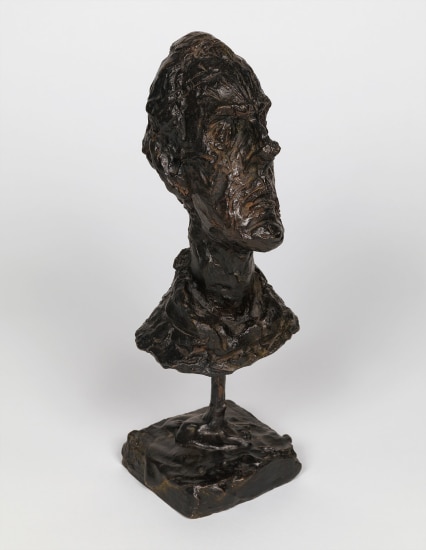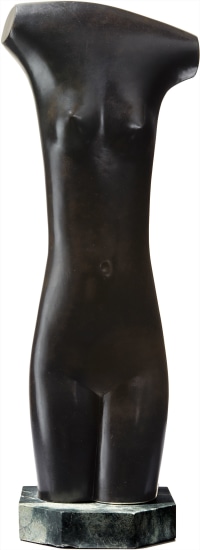Alberto Giacometti ‘Tête de femme’ table lamp designed 1937, later cast Patinated bronze, paper shade. 77.5 cm (30 1/2 in.) high, 48.3 cm (19 in.) diameter including shade Reverse impressed with AG 16. Together with a certificate of authenticity from the Comité Giacometti.
Provenance Lauren Bacall, New York Bonhams, New York, '20th Century Decorative Arts', December 17, 2015, lot 1023 Acquired from the above by the present owner Literature Michel Butor, Diego Giacometti Paris, 1985, p. 59 Françoise Francisci, Diego Giacometti Catalogue de l’œuvre, Volume I, Paris, 1986, pp. 26 , 27 Daniel Marchesseau, Diego Giacometti Paris, 1986, pp. 11, 35 Diego Giacometti Möbel und Objekte aus Bronze, exh. cat., Museum Bellrive, 1988, Zurich, p. 30 Christian Boutonnet and Rafael Ortiz, Diego Giacometti exh. cat., L'Arc en Seine, Paris, 2003, p. 35 Pierre-Emmanuel Martin-Vivier, Jean-Michel-Frank: un décorateur dans le Paris des années 30, Paris, 2009, p. 122 Catalogue Essay The present lot is registered by the Fondation Alberto and Annette Giacometti in the online Alberto Giacometti Database (AGD) under the number AGD 3497. Tête de femme – Lauren Bacall and Alberto Giacometti Recalling elements of an architectural caryatid, the form of Alberto Giacometti’s Tête de femme table lamp simultaneously features an unevenness and softness that reveals the artist’s hand. The dark brown patina of the bronze gives the object a subtle richness, whilst enhancing its sculptural quality. The use of bronze also links the lamp to a second classical form, the bust –a theme that preoccupied Giacometti throughout his career. However, it is the artistic intent behind the object’s considered detail and simplicity that gives the modern work its value. The Tête de femme lamp comprises part of the collection of decorative objects that Giacometti created for the influential interior designer Jean-Michel-Frank between 1932 and 1940. These objects became integral to the designer’s celebrated minimalist interiors, and Frank’s fashionable clientele became great admirers of the sculptor’s work. Frank positioned Giacometti’s lamps and vases prominently throughout his stark interiors, which were renowned for their luxurious materials, such as leather, marble, ivory and parchment. Translating the spirit of Frank’s ‘anonymity’ of forms and space, Giacometti worked from ancient forms. Giacometti traced the genesis of these forms, emptying them of their meaning, in order to retain only the essential. Evoking forms from ancient Greek, Roman, and Egyptian excavations, Giacometti’s decorative works reflect his admiration of these civilizations and his study of their utilitarian objects. However, devoid of any direct historical reference, these works retain a sense of mysterious anonymity, allowing the viewer to unconsciously construct the work’s form and meaning. Giacometti had joined the Surrealists in 1931 and although he parted ways with the group by 1935 elements of the movement remained in his work. By the mid-1930s Giacometti had returned his attention back to the depiction of the human figure, and specifically to the human head – the exploration of which would remain central to the artist’s work throughout his life. During this period the British painter and designer Isabel Rawsthorne became one of Giacometti’s primary models. Rawsthorne acted as a muse for several of her avant-garde contemporaries, and ultimately it is through these relationships that she has become largely remembered historically. Whilst the two artists developed a personal relationship, Giacometti and Rawsthorne shared artistic interests, including a commitment to a modern form of representational painting. Both artists were inspired by ancient figures, in particular Egyptian sculpture, which provided a model for Giacometti’s exploration of the individual versus the universal. These interests are expressed in the formal simplicity of the Tête de femme lamp’s totemic form, whilst the lamp’s stylised face bears a resemblance to Rawsthorne, whose face Giacometti likened to that of an Egyptian head. Giacometti first conceived of his Tête de femme lamp in plaster around 1937, from which he later cast an edition in bronze. The original plaster model of the lamp is now held
Alberto Giacometti ‘Tête de femme’ table lamp designed 1937, later cast Patinated bronze, paper shade. 77.5 cm (30 1/2 in.) high, 48.3 cm (19 in.) diameter including shade Reverse impressed with AG 16. Together with a certificate of authenticity from the Comité Giacometti.
Provenance Lauren Bacall, New York Bonhams, New York, '20th Century Decorative Arts', December 17, 2015, lot 1023 Acquired from the above by the present owner Literature Michel Butor, Diego Giacometti Paris, 1985, p. 59 Françoise Francisci, Diego Giacometti Catalogue de l’œuvre, Volume I, Paris, 1986, pp. 26 , 27 Daniel Marchesseau, Diego Giacometti Paris, 1986, pp. 11, 35 Diego Giacometti Möbel und Objekte aus Bronze, exh. cat., Museum Bellrive, 1988, Zurich, p. 30 Christian Boutonnet and Rafael Ortiz, Diego Giacometti exh. cat., L'Arc en Seine, Paris, 2003, p. 35 Pierre-Emmanuel Martin-Vivier, Jean-Michel-Frank: un décorateur dans le Paris des années 30, Paris, 2009, p. 122 Catalogue Essay The present lot is registered by the Fondation Alberto and Annette Giacometti in the online Alberto Giacometti Database (AGD) under the number AGD 3497. Tête de femme – Lauren Bacall and Alberto Giacometti Recalling elements of an architectural caryatid, the form of Alberto Giacometti’s Tête de femme table lamp simultaneously features an unevenness and softness that reveals the artist’s hand. The dark brown patina of the bronze gives the object a subtle richness, whilst enhancing its sculptural quality. The use of bronze also links the lamp to a second classical form, the bust –a theme that preoccupied Giacometti throughout his career. However, it is the artistic intent behind the object’s considered detail and simplicity that gives the modern work its value. The Tête de femme lamp comprises part of the collection of decorative objects that Giacometti created for the influential interior designer Jean-Michel-Frank between 1932 and 1940. These objects became integral to the designer’s celebrated minimalist interiors, and Frank’s fashionable clientele became great admirers of the sculptor’s work. Frank positioned Giacometti’s lamps and vases prominently throughout his stark interiors, which were renowned for their luxurious materials, such as leather, marble, ivory and parchment. Translating the spirit of Frank’s ‘anonymity’ of forms and space, Giacometti worked from ancient forms. Giacometti traced the genesis of these forms, emptying them of their meaning, in order to retain only the essential. Evoking forms from ancient Greek, Roman, and Egyptian excavations, Giacometti’s decorative works reflect his admiration of these civilizations and his study of their utilitarian objects. However, devoid of any direct historical reference, these works retain a sense of mysterious anonymity, allowing the viewer to unconsciously construct the work’s form and meaning. Giacometti had joined the Surrealists in 1931 and although he parted ways with the group by 1935 elements of the movement remained in his work. By the mid-1930s Giacometti had returned his attention back to the depiction of the human figure, and specifically to the human head – the exploration of which would remain central to the artist’s work throughout his life. During this period the British painter and designer Isabel Rawsthorne became one of Giacometti’s primary models. Rawsthorne acted as a muse for several of her avant-garde contemporaries, and ultimately it is through these relationships that she has become largely remembered historically. Whilst the two artists developed a personal relationship, Giacometti and Rawsthorne shared artistic interests, including a commitment to a modern form of representational painting. Both artists were inspired by ancient figures, in particular Egyptian sculpture, which provided a model for Giacometti’s exploration of the individual versus the universal. These interests are expressed in the formal simplicity of the Tête de femme lamp’s totemic form, whilst the lamp’s stylised face bears a resemblance to Rawsthorne, whose face Giacometti likened to that of an Egyptian head. Giacometti first conceived of his Tête de femme lamp in plaster around 1937, from which he later cast an edition in bronze. The original plaster model of the lamp is now held
.jpg)
.jpg)


.jpg)
.jpg)









Try LotSearch and its premium features for 7 days - without any costs!
Be notified automatically about new items in upcoming auctions.
Create an alert